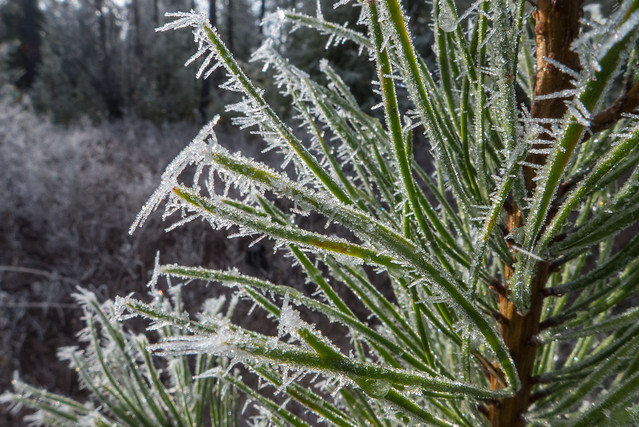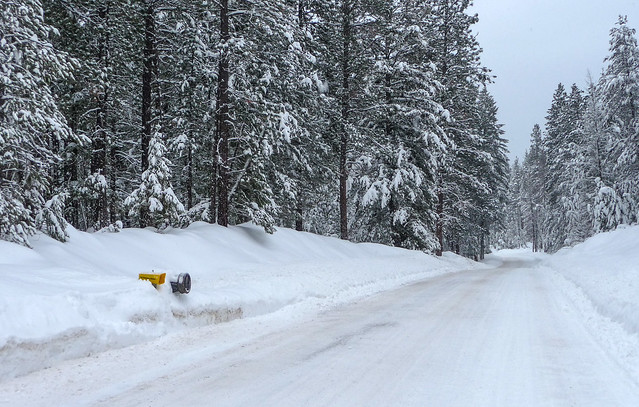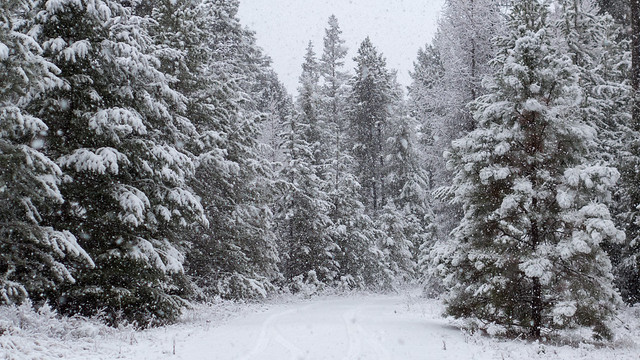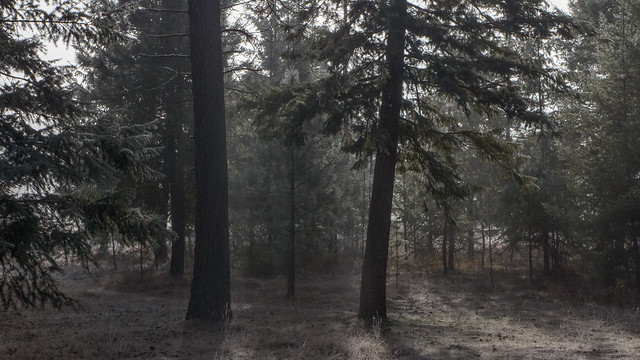When my mother called me on the morning of September 11, 2001 and said that a plane had hit the World Trade Center, my first reaction was, “So what?” I pictured the small wreck of a Cessna stuck into a few windows, an accident resulting from some grossly incompetent private pilot.
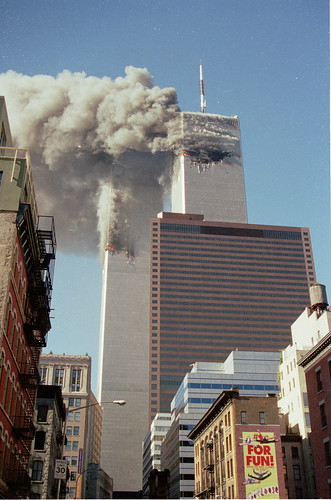
After I’d rubbed the sleep from my eyes and walked over to my computer to watch the live coverage online, I saw that huge plume of smoke and realized this was bigger than I’d thought. Then the second plane hit, and Islam–as envisioned by a small group of its most fanatically devoted followers–had introduced itself to my world.
In an effort to understand what my President was calling a “religion of peace,” I bought a paperback copy of the Qur’an1 and started reading. It didn’t seem all that peaceful to me. Just in the first three pages, Sura 2 (“The Cow”) went on and on about infidels who will receive “a severe chastisement,” whose hearts are diseased, for whom a fire has been prepared.
On page 17 (still in Sura 2), I encountered a command for Muslims to “fight for the cause of God against those who fight against you.” It was accompanied by the caveat that they should not attack the unbelievers first, at least, though that’s pretty much a moot point now, with Middle Eastern grievances stretching back many hundreds of years. Then, the text went on, “kill them wherever ye shall find them, and eject them from whatever place they have ejected you; for civil discord is worse than carnage.” With the sound still fresh in mind of turbofan engines and screams and bodies falling onto the pavement, this didn’t seem like a promising start.
And it wasn’t. Sura 8 (“The Spoils”) instructed the reader, in the name of “thy Lord” who’d apparently told some angels, “I will be with you: therefore stablish ye the faithful. I will cast a dread into the hearts of the infidels,” to “Strike off their heads then, and strike off from them every finger-tip,” because “they have opposed God and His Apostle.” Further instruction was to “Fight then against them till strife be at an end, and the religion be all of it God’s.” Sura 9 (“Immunity”) urged, “Believers! Wage war against such of the infidels as are your neighbors, and let them find you rigorous: and know that God is with those who fear him.”

Sura 24 (“Light”) sets forth a brutal punishment for the “whore and the whoremonger,” of the type that is still being carried out by faithful Muslims of ISIS and Saudi Arabia today: “scourge each of them with an hundred stripes; and let not compassion keep you from carrying out the sentence of God, if you believe in God and the last day.” Raif Badawi may have recalled the next line as the lash bore down on him in January: “And let some of the faithful witness their chastisement.” As he himself recalled it, “when I look within, I only see that thin man who miraculously withstood fifty lashes, while a group of people celebrated his pain, repeatedly chanting Allahu Akbar.” 2
The first verses of Sura 47 (“Muhammed”) included this framework for interfaith dialogue: “When ye encounter the infidels, strike off their heads till ye have made a great slaughter among them, and of the rest make fast the fetters.” Two pages later, it urged believers not to be fainthearted, “and invite not the infidels to peace when ye have the upper hand.” In Sura 66 (“The Forbidding”), the Prophet was told to “make war on the infidels and hypocrites, and deal rigorously with them. Hell shall be their abode! And wretched the passage to it!”
My passage through the text to this point had been pretty wretched, too. It was all so very repetitive, bleak, defensive, and angry. Denunciations of infidels were littered everywhere, along with copious eternal threats (“for the infidels is the torture of the Fire!”, Sura 8). There were provisions giving special privileges to slaveholders (“Forbidden to you also are married women, except those who are in your hands as slaves,” Sura 4) and the prophet (“No blame attacheth to the Prophet where God hath given him a permission,” Sura 33).

One entertaining diversion from the overall gloom of my reading project was coming across this license given by Allah to the man who (coincidentally!) was the very one to transmit the divine words:
O Prophet! We allow thee thy wives whom thou hast dowered, and the slaves whom thy right hand possesseth out of the booty which God hath granted thee, and the daughters of thy uncle, and of thy paternal and maternal aunts who fled with thee to Medina, and any believing woman who hath given herself up to the Prophet, if the Prophet desired to wed her–a privilege for thee above the rest of the faithful. [Sura 33, “The Confederates”]
That’s some real forward thinking on Mo’s part there. If you’re going to write a holy book, you might as well get all of your special sexual privileges defined right up front.
It’s an example of how “temporal power, aggrandisement, and self-gratification mingled rapidly with the grand object of the Prophet’s life” during the latter period of his life, in Medina. That characterization is from William Muir’s four-volume, mid-19th century biography Life of Mahomet, which the ex-Muslim writer Ibn Warraq says passed “a judgment on Muhammad’s character that was to be repeated over and over again by subsequent scholars.” Muir observed that Muhammad’s “personal indulgences were not only excused but encouraged by the divine approval or command.” In addition, “Battles were fought, executions ordered, and territories annexed, under cover of the Almighty’s sanction.” 3 The Arab pagans of the 7th century had plenty to be Islamophobic about.4
The Prophet also seemed–to my layman’s reading at least–pretty touchy about the idea that his revelations might be questioned. He has Allah proclaim reassuringly that infidels like me will say, “This Koran is a mere fraud of his own devising, and others have helped him with it, who had come hither by outrage and lie” (Sura 25, “al Furkan”). We unbelievers scoff at Allah’s “distinct signs” by saying, “This is merely a man who would fain pervert you from your father’s worship,” and “This (Koran) is no other than a forged falsehood” (Sura 34, “Saba”).
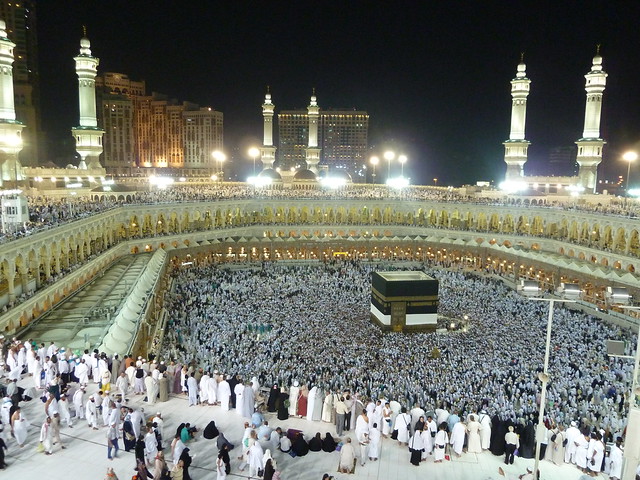
But wait! Sura 41 (“The Made Plain”) provides a handy rationalization for our skepticism. It’s one that sounds all too familiar from my days in Christian fundamentalism: The Qur’an “is to those who believe a guide and a medicine; but as to those who believe not, there is a thickness in their ears, and to them it is a blindness.” 5
I’ll agree to that, at least. In all those pages, I saw nothing about love, nothing about joy or any real wisdom. It looks to me like blindness, all right–to everything that is good and decent about humanity.6
Edward Gibbon (1737-1794), famous historian of the Roman Empire, wasn’t impressed, either. The Qur’an he called an “endless incoherent rhapsody of fable, and precept, and declamation, which seldom excites a sentiment or an idea, which sometimes crawls in the dust, and is sometimes lost in the clouds.” Philosopher David Hume (1711-1776) was even less charitable, calling it a
wild and absurd performance. Let us attend to his [Muhammad’s] narration; and we shall soon find that he bestows praise on such instances of treachery, inhumanity, cruelty, revenge, and bigotry as are utterly incompatible with civilized society. No steady rule of right seems there to be attended to; and every action is blamed or praised, so far only as it is beneficial or hurtful to the true believers.7
The Qur’an and Muhammad’s sword are, in the assessment of biographer Muir, “the most stubborn enemies of Civilization, Liberty, and Truth, which the world has yet known.” 8 Admittedly, in the 150 years since he wrote that, we have seen plenty of uncivilized behavior totally unrelated to Islam or even religion–the Holocaust, Stalin’s murder of millions, the Bataan death march, and my own country’s detonation of two nuclear bombs over civilian populations come to mind. But we are also still seeing all too much of the bloody sword of Muhammed, not just in the Middle East, but in the concert halls, banquet rooms, and subway stations of the Western world.
Submit or Die
Nor is Liberty (to say nothing of an impartial search for Truth) a viable partner with Islam. Its very name–meaning “submission” or “surrender”–is contrary to that.9 Islam is a totalitarian ideology that hacks away at human rights and freedoms with two bloody edges of Muhammad’s sword: sharia, which subjugates those currently under Islamic control, and jihad, which seeks to extend that control to everybody else, having “for its ultimate aim the conquest of the entire world, in order to submit it to one single authority.”
The sharia or Islamic law is “based on four principles or roots.” 10 One of course is the Qur’an, with all its restrictions and barbaric punishments. And it’s not going anywhere. Even the moderate Muslim reformer Maajid Nawaz, who is doing much-needed work to help promote a tolerant (and tolerable) form of Islam, admits that “most Muslims today believe that the Qur’an is the eternal, literal word of God.” 11
The other three principles behind sharia are “the sunna of the Prophet, which is incorporated in the recognized traditions; the consensus (ijma) of the scholars of the orthodox community; and the method of reasoning by analogy (qiyas or kiyas).” The whole thing is a “doctrine of duties” that is
aimed at “controlling the religious, social and political life of mankind in all its aspects, the life of its followers without qualification, and the life of those who follow tolerated religions to a degree that prevents their activities from hampering Islam in any way.” . . . It intrudes into every nook and cranny: everything–to give a random sample–from the pilgrim tax, agricultural contracts, the board and lodging of slaves, the invitation to a wedding, the use of toothpicks, the ritual fashion in which one’s natural needs are to be accomplished, the prohibition for men to wear gold or silver rings, to the proper treatment of animals is covered.12
Warraq notes that Christianity has a biblical basis for separation of church and state (“Render unto Caesar the things which are Caesar’s and unto God the things which are God’s, Matt. 22:17), but there is no such separation with Islam. The reason goes back to Muhammed, who
was not only a prophet but also a statesman; he founded not only a community but also a state and a society. He was a military leader, making war and peace, and a lawgiver, dispensing justice. Right from the beginning, the Muslims formed a community that was at once political and religious, with the Prophet himself as head of state.13
“Western Islamic apologists and modernizing Muslims continue to look for democratic principles in Islam and Islamic history,” says Warraq, noting many reasons why their search will be in vain. Perhaps most glaring is the legal inferiority of women, whose testimony in court is worth half that of a man, whose movements are strictly restricted, and who are prohibited from marrying non-Muslims. Non-Muslims of either sex who live in Muslim countries suffer their own form of subjugation, while atheists and apostates from Islam can expect only death. (Warraq notes Islam’s hypocrisy in welcoming converts who move in the other direction.)
Indeed, the very “notion of an individual–a moral person who is capable of making rational decisions and accepting moral responsibility for his free acts–is lacking in Islam.” One of the greatest obstacles standing in the way of any Islamic democracy is Islam’s “emphasis that it is the final word of God, the ultimate code of conduct: Islam never allows the possibility of alternatives.” 14
Mission Work, Muhammad Style
Intolerance was built into Islam from the very beginning. No “religious toleration was extended to the idolaters of Arabia at the time of Muhammad. The only choice given them was death or the acceptance of Islam.” The Prophet himself slaughtered around 600-900 Jews, expelled others, and subjugated the rest under extortionate taxes.
Then, just a couple of years after Muhammad’s death, “the caliph Abu Bakr organized the invasion of Syria,” expanding the reach of Islam outside the Arabian peninsula.
During the campaign of 634, the entire region between Gaza and Caesarea was devastated; four thousand peasants Christians, Jews, and Samaritans who were simply defending their land were massacred. During the campaigns in Mesopotamia between 635 and 642, monasteries were sacked, the monks were killed, and Monophysite Arabs executed or forced to convert. In Elam the population was put to the sword, at Susa all the dignitaries suffered the same fate.15

About 70 years later, the Umayyad Caliphate, “the second of the four major Islamic caliphates established after the death of Muhammad,” 16 provided another example of such early barbaric behavior. Another Muhammad, bin Qasim, was a commander tasked with conquering the Sindh and Multan regions of what is now Pakistan. According to Warraq’s recounting of this bit of early jihadist history, the commander had instructions from Al-Hajjaj ibn Yusuf, governor of Iraq, to “bring destruction on the unbelievers.” He was “to invite and induce the infidels to accept the true creed, and belief in the unity of God.”
This was not accomplished by door-to-door missionaries offering copies of the Qur’an. Al-Hajjaj prescribed harsh treatment and injury to anyone who “does not submit to Islam.” But after three days of slaughter at the port of Debal, it seems that commander bin Qasim got soft and allowed many of the inhabitants to stick with their religion.
The governor shot off a displeased letter to the commander via Indus Express, citing one of the same Qur’anic passages I did above, the one about striking off the heads of unbelievers. That was, he admonished, “a great command” that “must be respected and followed. You should not be so fond of showing mercy, as to nullify the virtue of the act.” 17 Alas, governor Al-Hajjaj hadn’t gotten the memo from Reza Aslan et al. that Islam doesn’t promote violence.
Iraq was at the center of the Umayyad Caliphate. It’s the same neighborhood as another Caliphate that exists in the Qur’an-crazed imaginations of our latest outbreak of Islamic fanaticism, the Islamic State or ISIS. Christopher Hitchens, who did not live long enough to witness the current horrors of ISIS, saw its genesis as “al-Qaeda in Mesopotamia,” in 2011 calling it “the fantastically sadistic and homicidal so-called ‘insurgency’ put together by the Jordanian jailbird and psychopath Abu Musab al-Zarqawi.” 18
In his recently published dialogue with Maajid Nawaz, Sam Harris recalled how the Islamic State had “been burning prisoners alive in cages and decapitating people by the dozen and gleefully posting videos attesting to the enormity of their sadism online.” These atrocities, he observed, “represent what they unabashedly stand for.” 19 Yet, when “one asks what the motivations of Islamists and jihadists actually are, one encounters a tsunami of liberal delusion.” 20
Nawaz acknowledges many of the difficulties Harris raises throughout their discussion, and laments “regressive leftists” (his words) who “have a poverty of expectation for minority groups, believing them to be homogeneous and inherently opposed to human rights values.” 21 Regarding the Islamic State, he notes that more “violence does not necessarily equate with greater religious conviction. Each group is deeply convinced of its approach to achieving Islamism in society, and both face much danger in pursuit of that goal.” Not only do “they differ in methodology,” but they also very much despise each other.” Islamic State, for example, “would kill members of the Muslim Brotherhood” in Egypt.22
His efforts to salvage something separate and worthwhile from “Islamism” are commendable, but knowing that various Islam-inspired groups hate each other as well as everybody else doesn’t make me feel much better about Islam itself. My “Islamophobia,” a term I accept for myself despite its pejorative intentions, is a very reasonable aversion to Islam. It is not a phobic (i.e., irrational) fear at all, but an entirely sensible response to something very dangerous.23 Frankly, I wouldn’t want either the Islamic State or the Muslim Brotherhood anywhere nearby.
Nawaz also attempts to draw a distinction between Islam and what the Islamic State is doing, as he and millions of other decent Muslims must. “Islam is just a religion,” he says, contrary to what we have seen above from Ibn Warraq about totalitarianism. “Islamism is the ideology that seeks to impose any version of Islam over society. Islamism is, therefore, theocratic extremism. Jihadism is the use of force to spread Islamism. Jihadist terrorism is the use of force that targets civilians to spread Islamism.”
“It is this extremism,” he says, “that must be named as Islamism and opposed,” adding “that one cannot argue that the Islamic State represents all of Islam.” Then, with refreshing candor, Nawaz goes on to admit the obvious:
one cannot argue that it has nothing to do with Islam. But it should be obvious that “a desire to impose Islam” cannot reasonably be said to have “nothing to do with Islam.” Clearly, it has something to do with it.24
Yes, it certainly does. And it has everything to do with those bloody bodies of innocents lying on the ground in Paris and San Bernardino.
The Empty Quarter
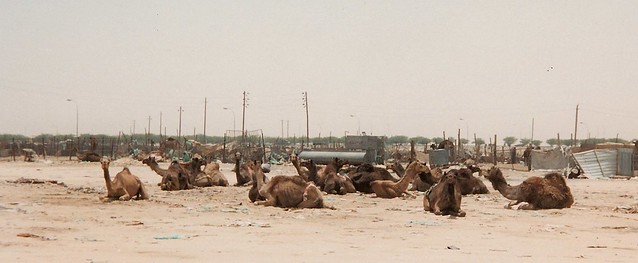
Perhaps the best example of a devoutly Islamic society today is the place where Islam got its start, the portion of the Arabian peninsula now governed by the Al-Saud. In the assessment of John Bradley, a rare Western journalist who had some real experience there, they are “perhaps the most corrupt family the world has ever known.” Saudi Arabia, he says, is
teeming with extremists, where children are taught that “the Jews” are the eternal enemy, and where Westerners are periodically blown up in their residential compounds or gunned down in the street by attackers filled with hatred for them and seeking martyrdom. It is a place that treats Third World immigrants like slaves, where Saudi men never get to see a woman who is not a direct (and usually very close) relative, and where Saudi women themselves cannot leave the house without a male chaperone, let alone drive, and live for the most part in absolute purdah [separation from men].
Fluency in Arabic, an eager cultural curiosity, and a willingness to risk living outside some fortified expat compound allowed Bradley to spend time in another Saudi Arabia. This was one
where Westerners with an open mind and sense of adventure can and often do encounter the finest traditions of Islamic hospitality, generosity, and kindness. In this Saudi Arabia, they may spend an evening sitting with liberal-minded, and even secular, Saudi friends, drinking coffee in Starbucks while talking about the latest Western movies. Princes and princesses, selfless and incorruptible, can talk passionately of the need to introduce sweeping reforms that would limit their own power. Teenagers surf the web in Internet cafes while watching the World Cup or Superbowl on widescreen TVs, or play soccer in the street. Women, shed of their long black cloaks in the home, can quickly prove themselves to be as independent and single-minded as any in the West.25
Guess which version of the country is more faithful to Islam? Despite that business about “Islamic hospitality,” which I suspect is really no different than Arabic hospitality, it is the first one–the repressive, hate-filled, all-controlling Saudi Arabia–that has enacted a bleak dystopia of pure Islam. The “universities, charities, schools, orphanages, and print media are all . . . now in the control of the Wahhabi clerics,” spewing and sowing the seeds of extremist rhetoric, indoctrinating the next generation with the joys of jihad and martyrdom.26

For this we can thank the British and their tragic decision in the 1930s to back a certain Abdulaziz Ibn Saud,27 whom they “viewed as the leader most likely to pacify rival tribes in the Arabian Peninsula and [who] had already proved himself very willing to cooperate closely with Britain in order to achieve his goal of carving out a state for his family to rule over.” 28
Ibn Saud did not arrive on his own. He was accompanied, like a dog with a bad case of worms, by clerics who followed the depressingly fundamentalist Islam of one Muhammad ibn Abd al-Wahhab, who had signed a pact with Ibn Saud’s ancestor back in 1744. “Their aim was to bring about, through force if necessary, the reign of the word of God.” Sound familiar? “Abdul Wahhab had begun his preaching some years earlier. Wahhabism, his legacy, advocated a literalist and legalistic stance in matters of faith and religious practice.” 29
Now, more than two hundred years later, the Saudis remain “loyal to the cynical pact that earned Wahhabi clerical endorsement of the ruling dynasty in return for heavy subsidy of Wahhabi clericalism,” as Hitchens observes.30 Together they have produced a miserable cultural desert where the only form of public entertainment, apart from soccer matches, are the beheadings that take place in “chop-chop square.” 31
Funded by the second-largest oil reserves on the planet, Allahu Akbar, they are “putting billions of dollars at the disposal of madrassas and mujahidin alike” to infect the rest of the world with their toxic meme of Islamic madness.32 And once again, the darkness has made its way north from the Arabian Peninsula to Iraq:
For their guiding principles, the leaders of the Islamic State, also known as ISIS or ISIL, are open and clear about their almost exclusive commitment to the Wahhabi movement of Sunni Islam. The group circulates images of Wahhabi religious textbooks from Saudi Arabia in the schools it controls. Videos from the group’s territory have shown Wahhabi texts plastered on the sides of an official missionary van.
There’s one difference, which is of critical importance to Saudi Arabia itself: “Wahhabi scholars preach obedience to earthly rulers,” probably because they themselves are captive to the House of Saud. ISIS wants to do the ruling and taxation (i.e., extortion) itself in Iraq and Syria, not just the kind of religious propagandizing and religious policing that the Wahhabis handle in Saudi Arabia. Despite that and the Islamic State’s absolutist “with us or against us” attitude, which made even the likes of Al Qaeda uncomfortable, “a certain mutedness” lingered among the Wahhabis about ISIS. Finally, King Abdullah, a sort-of-secular ruler put in an uncomfortable position by all this Islamic caliphate business, “publicly urged them to speak out more clearly.” 33
Calling the project of ISIS “nothing more than reviving the Wahhabism of the founding generation” and noting how the Islamic State’s leadership “absorbed the Wahhabi doctrine and mastered all its details,” Saudi researcher Fouad al-Ibrahim explains in one tidy sentence the Wahhabi clerics’ reluctance to condemn ISIS: It “adopts a global project that Wahhabism tried to achieve from the mid-eighteenth century until the end of the 1930s.” But that is a serious threat to the House of Saud, “which seeks to undermine any internationalist project that might reach within its borders.” 34 The nation is, after all, the product of Al-Saud’s bloody victory over and repression of “various tribes, sheikhdoms, emirates, and kingdoms” across the Arabian Peninsula.35

The Saudi dog is feeling pretty sick nowadays from that load of Wahhabi worms it carries. But none of its symptoms, or the manifest moral failings of the Al-Saud family itself, can be publicly acknowledged by Saudi Arabia’s oil-thirsty clients. The Obama administration surely recognizes how tenuous our own oil supplies are, 45 years after the peak of conventional crude production in the U.S.36 And don’t count on hydraulic fracturing to keep your gas tank full for long: The depletion rate of those fracked wells in the Bakken is averaging 85% three years after drilling.37 If that upward spike at the end of the graph above looks anomalous to you, you’re on to something. It’s not gonna last.
Until the supergiant oil fields that lie beneath the sands of Saudi Arabia finally run dry, the United States will remain in what Bradley calls a “fundamentally absurd and self-contradictory ‘special relationship’ with the Kingdom “that has stood since February 1945, when Ibn Saud met President Roosevelt on the USS Quincy in the Suez Canal.” 38 We will continue to look the other way as the cowled barbarians of Riyadh lash and behead their bloggers and poets and make a mockery of the U.N. Human Rights Commission, and as their Wahhabi parasites continue promoting toxic Islamism around the world.
We may not have that long to wait before the whole pathetic charade comes to an end. Ghawar, the biggest of the supergiants, which alone supplies 60% of the Kingdom’s output, has been producing for nearly 70 years. The notoriously secretive Saudi Aramco reported that it had gotten about halfway through the field’s proven reserves in 2008, and it may well have peaked a few years before then.39
Withdrawal symptoms will be severe, of course, for a world grown addicted to this black tar heroin from the earth’s depths. Nor can we expect Saudi Arabia to face its own austerity with much good grace. It will finally exhaust its last ancient reserves of groundwater40 along with the fossil energy it needs to run desalination plants, along with the sole economically viable export it can trade for food from the infidel world its clerics hate and condemn.
The place is an overpopulated hellhole, hotter than ever due to climate change 41 and packed full of unemployed and entitled youth who have no work ethic, useful knowledge, or positive role models to fall back on once the handouts stop. A large part of what their educations have been about is the hatred of others, repression, and jihad. There a “complete lack of any kind of youth culture.” Except for a bit of four-wheeling out in the sand dunes,
young Saudis who do not have the means or desire to travel abroad remain, by and large, locked away with their frustration in their bedrooms, watching satellite TV, surfing the web, and contemplating an increasingly difficult life in a kingdom full of unemployment, poverty, repression, and nepotism. That, of course, is great news for radical Islamists, ever-eager to recruit to their ranks young men who have few critical faculties and a crudely simplistic world outlook. With so many youngsters wandering aimlessly into adulthood with increasingly few prospects of a decent job, ruled by a corrupt elite closely aligned to an America the young are told to hate and hold responsible for Israel’s ruthless suppression of the Palestinians, the call of the Islamists is not falling on deaf ears.
Their “essentially shallow understanding of Islam” has been taught to them “by hard-line Wahhabi teachers and clerics,” and it “sits in their minds like a highly combustible tinder box, just waiting for a loose spark to set it alight.” 42
Watch out, world. Things are just getting started.
A Civilized Defense of Civilization
Is it any wonder, gentle reader, why I fear and loathe this ancient and insidious Arabian export? Yes, indeed, I am an Islamophobe. I embrace the slur that was intended to shame people into not questioning this totalitarian belief system, just as some gays have decided to embrace the term “queer.”
Islam is different, of course, than a race or an innate sexual orientation. It is a belief system, one that aspires to be more than just a religion. A religion it is, though, and as such, our Constitution and sense of human decency (not shared by Islamists or a certain narcissistic presidential candidate) demand that we tolerate its free exercise. At least to the extent that it doesn’t threaten us with harm, which is an important caveat.
But I damn well don’t welcome its spread into Western society, nor do I intend to be kept silent about it. Even so, more out of consideration for your attention than the hair-trigger sensitivities of Islamists and their doe-eyed apologists, this essay has glided pretty gently over the atrocities and pain that Islam inflicts, and has from the very beginning, on its followers and resisters alike. Some of its crimes against women so disgust me that I have declined to mention them at all.
Nor have I said much about the combination of mental anguish and physical danger it poses for those who dare to shake off its cold embrace, probably unequaled in any other religion. There too, many gripping stories could be told here, like the one from “Jamila” who wrote recently about the question of when the apostasy she’s been hiding will come out and tear her apart from her family. That troubling question–when?–lurks
in the double life I live with the man who shares my bed after my father drops me home, it’s there telling me that I can’t keep him a secret forever. It’s there in the folds of the headscarf I pull out of my drawer on visit days, whispering to me that if I don’t tell them, the lies, like the material I drape over my head, will suffocate me. It’s there in slight hesitation in my voice when I recite the duaas to younger siblings and I wonder if they realise that this is not the recitation of a person who prays regularly. It’s there, it’s there, it’ll destroy us again one day, and I don’t know how to stop it.43
You can see more of this personal evidence about the iron grip that Islam keeps on its subjects via the /r/exMuslim subreddit and the #ExMuslimBecause Twitter hashtag, and by following the work of courageous and vocal ex-Muslims like Maryam Namazie, Faisal Saeed Al Mutar, Riz Rashid, Ali A. Rizvi, and Aliyah Saleem. And be sure to read the sobering article by Suraiya Simi Rahman, MD–an ex-Muslim who has lived in Bangladesh, the UAE and Pakistan–in which she says one “really can’t tell until the moment before they pull the trigger, who is moderate and who is jihadi.”
These people are all standing up to the many bullies and defenders of Islam, not just mullahs and creepy ISIS shills, but their own families and even–dismayingly–supposed feminists and leftists whose good intentions have somehow been co-opted to serve the Islamist meme. I have tremendous respect for the courage and strength of character that ex-Muslims have shown. To help support them, I’ve made donations to each of two important organizations that assist people like them on their difficult journeys to freedom: the Ex-Muslims of North America and the Council of Ex-Muslims of Britain.
The stories of apostates from this backwards, controlling religion need to be told–more and more, and with polite but firm criticism of the religion itself. Ibn Warraq was another one who courageously did so, regardless of the risks. “Without criticism,” he writes, “Islam will remain unassailed in its dogmatic, fanatical, medieval fortress; ossified in its totalitarian, intolerant, paranoid past. It will continue to stifle thought, human rights, individuality, originality, and truth.” 44
Standing up to all that is a project of civilization well worth our effort, and with care to avoid adopting any of its loathsome aspects ourselves.
Notes
-
The Koran (Ballantine Books, 1993), based on an English translation by J.M. Rodwell. All of the following quotes are from there, as I encountered them during my reading. An ex-Muslim correspondent once advised me that the preferred spelling of the name is Qur’an, and so that’s the one I use here. ↩
-
Raif Badawi, 1000 Lashes (Greystone Books, 2015). For guidance on judicial amputation and crucifixion, see Sura 5 (“The Table”). The horrors of ISIS are, of course, merely the result of careful and uncompromising attention to the text. ↩
-
William Muir, quoted in Ibn Warraq’s Why I Am Not a Muslim (Prometheus Books, 2010), p. 87. Here I depart from my usual practice of only quoting from books that I’ve actually read. Hopefully you will excuse me for declining to slog through a four-volume biography of Muhammed written 150 years ago. I have read Warraq’s book, however, and highly recommend it. ↩
-
“The basis of the Islamic attitude toward unbelievers is the law of war; they must be either converted or subjugated or killed (excepting women, children, and slaves); the third alternative, in general, occurs only if the first two are refused. As an exception, the Arab pagans are given the choice only between conversion to Islam or death. Apart from this, prisoners of war are either made slaves or killed or left alive as free dhimmis or exchanged for Muslim prisoners of war” (Warraq at p. 181, quoting Joseph Schacht, An Introduction to Islamic Law). ↩
-
E.g., “the light shineth in darkness; and the darkness comprehended it not” (John 1:5). ↩
-
“But what about the Bible!” is the common interjection at this point by Islam apologists. Well, yes, what about it? I’ve amply criticized that collection of backwards and violent writings, in two books and plenty of essays. See, e.g., Gutting Your Kid for God, Moral Midgetry, Jehu’s Jihad, and Fighting Words. ↩
-
Both quoted in Warraq, p. 10. Again, I must confess to not having read the original works cited here. But it’s hard to imagine any context in which Gibbon and Hume might have written that would have made these scathing critiques much less forceful. Indeed, Warraq says Gibbon “painted Islam in as favorable a light as possible to better contrast it with Christianity” (p. 21). ↩
-
Quoted in Warraq at p. 88. ↩
-
“Islam is a verbal noun originating from the triliteral root s-l-m which forms a large class of words mostly relating to concepts of wholeness, safeness and peace. In a religious context it means ‘voluntary submission to God.’ Islām is the verbal noun of Form IV of the root, and means ‘submission’ or ‘surrender.’ Muslim, the word for an adherent of Islam, is the active participle of the same verb form, and means ‘one who submits’ or ‘one who surrenders.’ Believers demonstrate submission to God by serving God, following his commands, and rejecting polytheism” (Wikipedia). That part about “following his commands” is problematic, of course, when they include the Qur’anic violence described above. ↩
-
Warraq at p. 163. ↩
-
Sam Harris and Maajid Nawaz, Islam and the Future of Tolerance: A Dialogue (Harvard University Press, 2015), loc. 626. ↩
-
Warraq at p. 163. I have taken the liberty of replacing Warraq’s quotation remarks with italics in quotations that include Arabic words. ↩
-
Warraq at p. 164. ↩
-
Warraq at pp. 172-73, 83-84 ↩
-
Warraq at p. 215-16, 219-20. ↩
-
Umayyad Caliphate, Wikipedia. ↩
-
Warraq at p. 220, writing about Al-Hajjaj ibn Yusuf, governor of Iraq and his commander Muhammad bin Qasim in 712 A.D. The passage is Sura 47.4, which reads as follows in Warraq’s quotation of Hajjaj’s letter: “O True believers, when you encounter the unbelievers, strike off their heads.” ↩
-
Christopher Hitchens, The Enemy (2011), loc. 124. ↩
-
Harris and Nawaz at loc. 706. ↩
-
Harris and Nawaz at loc. 457. ↩
-
Harris and Nawaz at loc. 481. ↩
-
Harris and Nawaz at loc. 425. ↩
-
See also this truly excellent video counter-argument to the silly and pernicious “Islamophobia” meme. ↩
-
Harris and Nawaz at loc. 1196. ↩
-
John R. Bradley, Saudi Arabia Exposed: Inside a Kingdom in Crisis (St. Martin’s Press, 2015). ↩
-
Bradley at loc. 1223, 1237. ↩
-
His full name, in case you were curious, is Abdulaziz ibn Abdul Rahman ibn Faisal ibn Turki ibn Abdullah ibn Muhammad Al Saud (Wikipedia). ↩
-
Bradley at loc. 235. ↩
-
Bradley at loc. 243. ↩
-
Christopher Hitchens, The Enemy (2011), loc. 172. ↩
-
Bradley at loc. 2537 ↩
-
Hitchens at loc. 172. ↩
-
David K. Kirkpatrick, “ISIS’ Harsh Brand of Islam Is Rooted in Austere Saudi Creed.” New York Times, September 24, 2014, nyti.ms/Y4erG6. ↩
-
Fouad al-Ibrahim, “Why ISIS is a threat to Saudi Arabia: Wahhabism’s deferred promise.” Al-Akhbar, August 22, 2014. english.al-akhbar.com/node/21234. ↩
-
Unification of Saudi Arabia, Wikipedia. ↩
-
Hubbert Peak Theory, Wikipedia. ↩
-
J. David Hughes, Drilling Deeper: A Reality Check on U.S. Government Forecasts for a Lasting Tight Oil & Shale Gas Boom (Post Carbon Institute, 2014). shalebubble.org/drilling-deeper. ↩
-
Bradley at loc. 1374. ↩
-
Bradley at loc. 1863. ↩
-
Nathan Halverson, “What California can learn from Saudi Arabia’s water mystery.” Reveal, April 22, 2015. Center for Investigative Reporting (link). ↩
-
John Schwartz, “Deadly Heat Is Forecast in Persian Gulf by 2100.” New York Times, October 26, 2015, nyti.ms/1LRVcSO (“By the end of this century, areas of the Persian Gulf could be hit by waves of heat and humidity so severe that simply being outside for several hours could threaten human life”). ↩
-
“I craved too much the warm welcome home,” atheistinaheadscarf.wordpress.com. ↩
-
Warraq at p. 14. ↩




